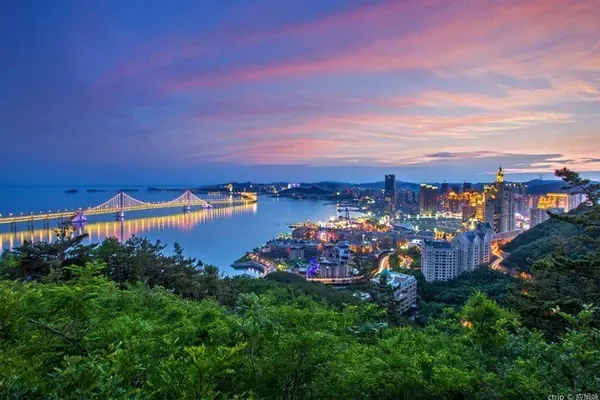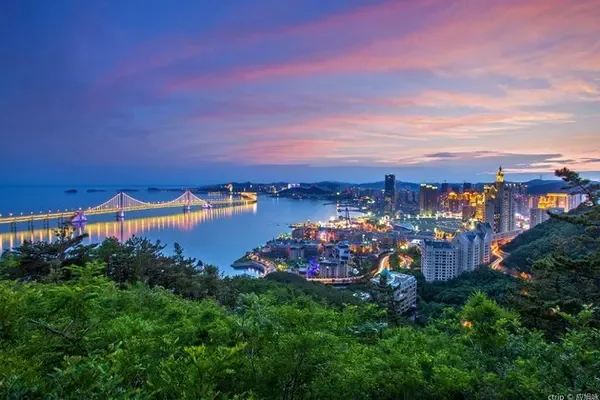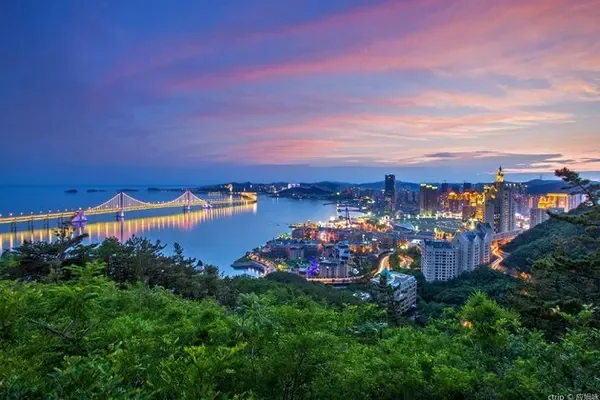It includes all kinds of city life in old Beijing and fashion culture in new Beijing.
As the capital, Beijing has always shown us its cultural diversity. There are not only the traces of life left by the old imperial city, but also the modern atmosphere of a fashionable city. There are not only traditional snacks with soy sauce, but also Michelin-level high-end cuisine. There are not only alley stringers carrying cages and birds, but also handsome men and women in exquisite clothes.
Day 1: The majesty of Chang'an Avenue in the imperial capital
Today, visit the buildings along Chang'an Avenue, which is the place that best reflects the charm of the capital of Beijing. Start from the front gate in the morning, cross Chang'an Avenue from south to north, visit the Forbidden City in the afternoon, and finally enjoy the panoramic view of the Forbidden City on Jingshan as the end.
09:00 Qianmen Street: The only preserved ancient city gate in Beijing
This 845-meter-long Qianmen Street is located on the central axis of Beijing. There are many time-honored shops in Beijing (Neiliansheng Shoe Store, Jingfan, Duyisiu Mai, etc.), most of which have retained the traditional economic methods. retro. The Zhengyang Gate on the north side of the street was one of the nine city gates in old Beijing at that time, and it was also the place guarded by the "Nine Gate Admirals" in the film and television drama.
Zhengyangmen consists of three parts: the city tower, the archery tower and the urn city. The urn city and the city tower have been demolished, and only the archery tower remains, which was nicknamed "Qianmenlouzi" by old Beijing. Climbing up the tower, you can learn about the history and customs of Beijing in the exhibition halls on each floor.
How to get there: Take Metro Line 2 and get off at Qianmen Station or take a bus to get off at Qianmen Station, and it is within walking distance.
Tickets: Free
10:00 Tiananmen Square: the center of the imperial capital
Tiananmen Square is located on the central axis of Beijing. The center of the square is the Monument to the People's Heroes, the Great Hall of the People is on the west side, the National Museum is on the east side, and the famous Tiananmen Gate Tower is directly opposite Chang'an Avenue.
Taking photos in front of Tiananmen Square has become a check-in place for countless travelers. The bright flower beds, chairman statues, majestic towers, and heroic guard posts are all indispensable scenery on the square. one.
On the west side of the Great Hall of the People, there is a beautiful "egg"-shaped steel building. This is the new landmark National Center for the Performing Arts on Chang'an Avenue. The theater has three professional theaters: a concert hall on the east side, an opera house in the middle, and a drama theater on the west side, meeting the entertainment and cultural needs of people of all ages. Travelers who are interested in operas, dramas or concerts can come here to enjoy a performance after visiting the Forbidden City, but remember to book tickets in advance.
Tickets: 30 yuan for visiting tickets
Touring the Forbidden City can be fast or slow, concise or simple. For ordinary tourists, it is generally divided into three tour routes: the middle, the east and the west. You can choose one of the routes, enter from Tiananmen Gate, and exit from Shenwu Gate. It takes about 2-4 hours . If you are interested in ancient architecture, you can also spend a day walking all three routes.
Central Line (Red) Central Axis Hall of the Forbidden City
Suitable for the crowd: Essence tours of all ages. This route takes the shortest time to visit, about 2 hours. It mainly shows the charm of the imperial power of the Ming and Qing dynasties. The three front halls (Taihe Hall, Zhonghe Hall, and Baohe Hall) are the places where the grandest and most solemn ceremonies are held, and where the emperor accepts worship from officials. Places for daily life and religious worship. West Line (Blue) Three Front Halls - West Sixth Palace
Suitable for the crowd: For history lovers, this route takes the longest time to visit, about 3.5-4 hours. After visiting the three main halls, pass through the East Sixth Palace and arrive at the Fengxian Hall (Hall of Clocks and Watches), where exquisite workmanship of the Qing Dynasty court is exhibited. Most of the clocks and watches come from western countries such as Britain and France. Then go to Ningshou Palace (Treasure Hall), which houses all kinds of rare treasures in the Qing court.
Tickets:
April 1st - October 31st
Adult ticket 60 RMB / student ticket 20 RMB
November 1st - March 31st of the following year
RMB 40 for adults / RMB 20 for students
opening hours
April 1-October 31, 8:30-17:00 closed on Monday
November 1st - March 31st of the following year 8:30-16:30 Closed on Monday
Jingshan is only 89 meters above sea level, and it takes about half an hour to reach the top of the mountain. Overlooking the Forbidden City from the top of the mountain, you will feel the majesty and shock of the Forbidden City more than visiting the Forbidden City. In addition, this is a good location to take a panoramic view of the Forbidden City. If you have enough time, you can rest and enjoy the scenery at the Wanchun Pavilion on the top of the mountain. When the sun sets, the light is just right, which is a good time to take a panoramic view of the Forbidden City at dusk.
Day 2 Old Beijing Hutong Chuanzi
Today, visit the traditional architectural complexes of old Beijing, go to Prince Gong’s Mansion to experience the life of princes and nobles in the Qing Dynasty, go to Shichahai to see the various forms of the old Beijing’s market, then go to the Internet celebrity scenic spot Nanluoguxiang to visit the cultural and creative shops, and visit Yonghe in the afternoon Palace, feel the Tibetan Buddhist culture in Beijing, and finally listen to a Live performance at a bar in a nearby Hutong alley as the end of the day.
09:00 Prince Gong’s Mansion: The residence of Heshen and Prince Gong
Prince Gong’s Mansion fully embodies the architectural style of the prince’s and noble’s mansions in the Qing Dynasty. The layout is exquisite and the style is extraordinary. It is an exhibition about the culture of the royal palace in the Qing Dynasty.
The back building connecting the front hall and the back garden is the essence of the palace. The whole building is 156 meters long, with carved beams and painted buildings on the front, but gray tiles and gray bricks on the back. all the same.
Tickets:
Ordinary ticket: 40 yuan
Half ticket: 6-18 years old, >60 years old
Free of charge: Retired cadres, younger than 6 years old
April 1-October 31 08:00-17:00
November 1st - March 31st 09:00-16:00
11:00 Houhai: the back garden of the royal relatives
Starting from Prince Kung’s Mansion, walk along Houhai all the way to the Drum Tower. After walking around this circle, you can see the interweaving of traditional culture and modern life in Beijing. The crooked alleys are full of former residences of famous historical figures. Behind every locked door, there may be a history of hundreds of years. Among these ancient buildings, there are many bars interspersed. This is the first stop for most young people who love to sing to choose Beipiao to realize their dreams.
12:30 Nanluoguxiang: Gathering of online celebrity shops
When you come to Nanluoguxiang, the recommended way to visit is to visit small art shops, soak in coffee shops, and taste creative food. It is worth mentioning that the Central Academy of Drama is also nearby. If you have enough time, you can watch a performance in the experimental theater next to the academy.
However, due to a lot of publicity in recent years, Nanluoguxiang has become famous, and there are many tourists all year round. During the peak tourist season, the main road is crowded with people, making it difficult to walk. Travelers who like cleanliness can take a walk around the small fork road next to it. There are many popular gourmet shops hidden in these small fork roads.
Today's Lama Temple is regarded by Beijingers as the most efficacious temple in the area. Every year on the first day of the Lunar New Year, there are even more than 40 hours of queuing for burning incense sticks. Wanfu Pavilion is the tallest building in the temple, and there is a standing statue of Maitreya Buddha enshrined in the hall. This 18-meter-high Buddha statue is carved from a whole root of white sandalwood and has been included in the Guinness Book of World Records.
Tickets: 25 yuan, cash only
November 1st - March 31st of the following year 09:00-16:00
April 1-October 31 09:00-16:30
LiveHouse is a bar for small bands to perform live. In the alleys around the imperial city of Beijing, there are many band performances of different styles hidden. In LiveHouse, order a drink and watch a performance that interests you. A popular experience for people visiting Beijing.
Recommended LiveHouse: Jianghu, Yuwenyishan, MAO Livehouse, Candy three floors
The third day: the trendy gameplay in the imperial capital
Today, you can experience Beijing’s modern urban architecture and avant-garde trend culture. Go up to visit the Bird’s Nest and Water Cube, the main venues for the Olympic Games. In the afternoon, take the subway to 798 to experience Beijing’s modern art atmosphere. In the evening, go to Sanlitun, where fashionable young people in Beijing often meet and go shopping place.
09:00 Olympic Park - Bird's Nest (a stadium that can accommodate 90,000 spectators)
This stadium, which resembles a bird's nest, is entirely made of steel frame structure. It is one of the host venues for the 2008 Beijing Olympic Games, and it undertook the opening and closing ceremonies and various events. Standing in the distance to watch the Bird's Nest, not only will have a good visual impact, but also a check-in seat for taking pictures, and being in the stadium, this stadium that can accommodate 90,000 spectators looks very grand and spectacular.
Water Cube: a cube made of environmentally friendly membranes
The "Water Cube" on the other side of the bird's nest looks like a box wrapped in bubbles, which is very interesting. The museum is not only for visiting, but also has a "warm-up pool" built in full accordance with international competitions and a "water park" suitable for all ages for tourists to have fun.
Tickets:
Visit ticket 30 yuan
Warm-up pool 50 yuan/2 hours
Water park 200 yuan
09:00-21:00
14:00 798 Art Zone: A Paradise for Contemporary Art
The 798 area is an art industrial park with a factory building style. It used to be a radio factory, but now it brings together various well-known galleries, art institutions and individual studios, and often holds various exhibitions about art. There are many sculptures of different shapes in the park, and the exterior walls of the galleries are covered with all kinds of interesting graffiti. Even if you don’t visit galleries, the park itself is a good background for fashion street photography.
Recommended galleries: B.T.A.P Tokyo Gallery, Ullens Center for Contemporary Art, Pace Gallery
18:00 Sanlitun: Gathering place for online celebrity street photography
This area of Sanlitun gathers trendy men and women in Beijing, and it is also one of the most frequent scenes in many street photography. The long guns and short cannons in Taikoo Li Square will inevitably cause troubles for tourists. The teacher can politely refuse.
There are many ways to play in Sanlitun. You can first go to the Village to shop for fashion brands, and then have a meal of exotic cuisine. This area is also a gathering place for foreigners, so the exotic cuisine here is not only rich in variety, but also very authentic. If you are energetic, you can have a drink with friends in the bar street next to it at night. Unlike the LiveHouse in the alley, the bar here is more lively.
Day Four: The Splendor and Ruin of the Royal Gardens
Visit Beijing’s Haidian District today. In the morning, go to the Summer Palace to feel the charm of the imperial gardens of the feudal empire, and then go to the Old Summer Palace to marvel at the ups and downs of history among the ruins. In the afternoon, visit Peking University to experience the cultural charm of the institution of higher learning.
09:00 Summer Palace: a model of feudal royal gardens
The Summer Palace has beautiful scenery all year round. Walking on the "West Causeway" in spring, the eyes are full of red peach blossoms and green willow trees; in summer, you can go boating on Kunming Lake to cool off; It even makes the whole yard covered in silver.
Tickets:
From April 1st to October 31st, 30 yuan
From November 1st to March 31st of the following year, 20 yuan
April 1-October 31 06:30-18:00
November 1st - March 31st of the following year 07:00-17:00
Yuanmingyuan is known as the garden of ten thousand gardens, and now, all the rare treasures here have been looted, and in Haiyan Hall, replicas of the twelve animal heads that are difficult to recover even with huge sums can be seen. In the park, the most worthwhile sight is the Dashuifa site in the Xiyanglou Scenic Area, which is also the famous "picture of ruined walls and broken walls" in elementary school textbooks.
Tickets: 10 yuan
January 1st - March 31st, November 1st - December 31st
07:00-19:30
April 1-April 30, September 1-October 31
07:00-20:30
May 1st - August 31st
07:00-21:00
Drop by Peking University
Peking University, originally named "Beijing Normal University", is a well-known institution of higher learning recognized in China, and it is also an important stop for many parents to bring their children to visit Beijing. The campus is picturesque, with both the grandeur of the royal garden and the beautiful features of the Jiangnan landscape. Among them, the Boya Pagoda standing on the shore of the Weiming Lake is a representative scenery of the Peking University campus, and it is also the first choice for many photographers to take pictures of Peking University. No other choice.
07:30-21:50 The southeast gate is open to tourists, and you need to bring your ID card or household registration book to register at the school.
Day 5 Outskirts of the Imperial Capital
Visit the suburbs of Beijing today, climb the Badaling Great Wall in the morning, and be a hero for a while, and go to the Ming Tombs in the afternoon to feel the solemnity of the tombs of feudal emperors. You can choose to take a self-guided bus tour, or choose the Badaling-Ming Tombs one-day tour group at the Beijing Tourist Distribution Center.
10:00 Badaling Great Wall: the essence of the Ming Great Wall scenery
The Badaling Great Wall is divided into two routes, the south route and the north route. The southern route has fewer tourists, while the northern route is more difficult to climb, but the scenery is more exquisite. There are 12 watchtowers on the north line, of which the north 8th floor is the highest point of the Badaling Great Wall, and it is also the end point of most tourists visiting the Great Wall. There is a "Heroic Slope" stone tablet here, which is the place where everyone competes to take pictures.
tickets
From April 1st to October 31st, 40 yuan
From November 1st to March 31st of the following year, 30 yuan
opening hours
April 1st - June 30th, September 1st - October 31st
06:30-19:00
November 1st - March 31st of the following year
07:00-18:00
July 1st - August 31st
06:00-19:30
Arrival method: Take the bus No. 877 directly
The Ming Tombs are the mausoleum complex of 13 emperors in the Ming Dynasty. Currently, only three tombs, Changling, Dingling, and Zhaoling, are open. Among them, only the underground palace of Dingling is open to tourists. Visiting the Ming Tombs, you can understand To the Feng Shui layout of the royal tombs of the Ming Dynasty.
In addition, the Changling Museum displays all kinds of unearthed cultural relics such as phoenix crowns, civic hats, men's jade belts, hairpins, etc., which are very worth seeing.
![[Beijing Raiders] What to do when you come to Beijing for the first time?](https://www.anyonetrip.com/uploads/202412/05/65fadc4e76c4ddc8.webp)


